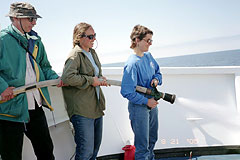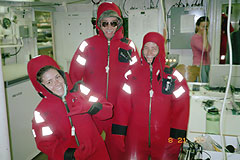

 | |||||||
|
|
Journals 2005/2006Maureen Barrett
August 29, 2005 Most of the day was spent off effort (with recorder watch only) due to the large swells and whitecaps. It was getting close to sunset, and we had not seen any cetaceans all day. Were we going to get skunked for the first time? That is when they came in; dolphins had appeared and decided to ride the ship's bow! The captain announced our visitors over the paging system for everyone to enjoy. They were short-beaked common dolphins (Delphinus delphis). These dolphins are about 8 feet in length and have a light gray or yellowish patch on their sides. It was amazing how fast they swam, zipping from side to side. Then I remembered the Jordan had a bow chamber. The bow chamber is a viewing area about ten feet below the surface and is lined with portholes on both the port and starboard sides. I soon found myself climbing down two decks to enter the chamber. It was entertaining watching the dolphins underwater until they lost interest in the ship and disappeared from sight. Even though the mammal observers were off effort, the ship's officers and crew were hard at work. The CO and the XO decided it would be a good day to conduct drills. Before starting the drills, they consulted with the Chief Engineer, Howard Boswell, about the timing of the drills to make sure they were not interfering with engine work. The Coast Guard mandates that ships perform drills on a weekly basis while ships are underway. Students and teachers are used to drills, especially fire drills. Laws require schools to have two drills per month. Some of you may have even experienced drills on cruise ships. It is a similar situation on scientific research vessels. Our first drill of the day was a fire and emergency drill. We were alerted to the drill by a prolonged bell over the paging system. The number and duration of bells sounded indicate the type of emergency. A bell lasting about ten seconds means a fire drill. The bell is followed by instructions stating what's on fire, the location of the fire, and what kind of fire it is. Everyone reported to their stations, then Executive Officer Paul Kemp instructed us on the particulars. He had the scientists actively involved in the drill, getting the fire hose ready and spraying the fire hose on the deck. He feels it is an asset to have all hands participating. There was also a personnel casualty drill built into the fire drill. With the victim on the stretcher, the XO discussed medical treatment of the injured crew member.
The next drill was the abandon ship drill. This was sounded by six short bells followed by one prolonged bell. For this drill, everyone must get their life jacket and immersion suit from their staterooms, and then report to the boat deck for further instructions from the XO. The immersion suit, or survival suit, is sometimes called a Gumby suit because of the Gumby appearance of all who put it on! There are six life rafts on the Jordan: three on the port side and three on the starboard side. There is a line to release the rafts into the water, or if the ship was sinking, the rafts would automatically deploy and inflate. Each raft is equipped with paddles, a survival manual, first aid kit, anchor and line, repair kit, flashlight, batteries, flares, and much more. The rafts were not inflated during the drill, but instructions were given as if they were deployed.
Another drill that must be performed is the man overboard drill. The Coast Guard requires this drill to be practiced once a month. With the sound of three prolonged bells, everyone reports to their stations and prepares for the rescue. Again, the officers make the most of everyone on board by having the scientists report to the flying bridge to serve as lookouts. After all, they are experts at observing things in the water. I feel safe on the David Starr Jordan and confident in Captain Von Saunder and her crew, even being 300 miles away from land and in waters over 12,000 feet deep! |
||||||

